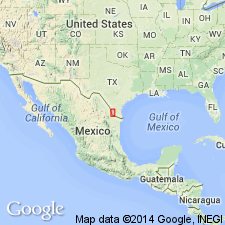
- Usage in publication:
-
- Roma sandstone member
- Modifications:
-
- Original reference
- Dominant lithology:
-
- Sandstone
- AAPG geologic province:
-
- Gulf Coast basin
Summary:
Pg. 1376, 1383, 1387. Roma sandstone member of Fayette formation. In lower part of Fayette formation. Exposed at International Bridge, San Pedro de Roma on Mexican side of Rio Grande from Roma [Starr County], southern Texas. Consists of 362 feet of soft coarse- to medium-grained light-gray sandstone with several horizons containing hard dark-brown calcareous concretionary masses and others containing brown hard nodular sandstone masses in very soft sandy matrix. Several gravelly and conglomeratic beds near base. A few oysters throughout the sandstone and a good fossiliferous bed of small bivalves at its base. Lies 183 feet above base of Fayette formation in section measured along both sides of Rio Grande between Roma and Rio Grande City [Starr County], southern Texas. [Age is late Eocene.]
[Present in southern Texas (Starr Co.) and adjacent part of Tamaulipas, Mexico.]
Source: US geologic names lexicon (USGS Bull. 896, p. 1839).

- Usage in publication:
-
- Roma sandstone tongue
- Modifications:
-
- Areal extent
- AAPG geologic province:
-
- Gulf Coast basin
Summary:
Pg. 259 (fig. 2), 268. Roma sandstone tongue of Fayette formation; Roma sandstone member of Fayette formation. Thickness 250 to 300 feet at Roma, Starr County, southern Texas. Thins northward and wedges out completely near Laredo. Composed almost entirely of massive and cross-bedded medium- to fine-grained sandstone which are fossiliferous (VENERICARDIA, HALYMENITES); large calcareous sand concretions common throughout member. Overlies Resendez shale tongue (member; new); underlies Gorgora shale member (new). [Age is late Eocene.]
Source: US geologic names lexicon (USGS Bull. 1200, p. 3331).
For more information, please contact Nancy Stamm, Geologic Names Committee Secretary.
Asterisk (*) indicates published by U.S. Geological Survey authors.
"No current usage" (†) implies that a name has been abandoned or has fallen into disuse. Former usage and, if known, replacement name given in parentheses ( ).
Slash (/) indicates name conflicts with nomenclatural guidelines (CSN, 1933; ACSN, 1961, 1970; NACSN, 1983, 2005, 2021). May be explained within brackets ([ ]).

